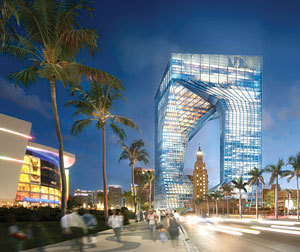BR: Chad, in addition to designing Ten Museum, you’re one of its developers as well. From a purely design perspective, what are the pros and cons of having an equity stake in a building?
CO: When I see a phenomenal opportunity, a location that hasn’t been tapped, and I can put together a proposal for a project that takes advantage of this, it’s like an actor creating his own vehicle—like Ben Affleck and Matt Damon writing Good Will Hunting so they could star in it.
[Having an equity stake] gives us a better opportunity to create great architecture as it gives us a certain control over the project. It has also helped us become more sensitive architects to the development realities faced by all our clients. It has added a level of knowledge in terms of business acumen. We’re always trying to push the architecture, but we’re always cognizant of the realities of building. Having a foot in both world helps us with clients because they are investing their money with us need and they need to make sure everything we do fits within the model of good business: We want to achieve the highest level of design within realistic parameters.

The slideshow includes more images of College Station, plus renderings of a billion-dollar hotel project in Las Vegas that Oppenheim is designing.
BR: You’ve just recently returned from Dubai, where it seemsy every big-name architect on the planet is working on a major project. What are you working on here—and what are the challenges of working in this environment?
CO: Every shape and form, every architectural idea, is being explored here. Everyone is torquing, splitting, shifting. It’s a challenging environment in that people are willing to do whatever it takes to bring attention to the market, so the question is how do you do something that will get recognized, and generate excitement, without being so outlandish that, if it’s a residential project, it still will sell?
We’re working on a few proposals here, taking the lessons we’ve learned in Miami about sustainable architecture, and architecture sensitive to its environmental context, with the goal of doing something timeless, not trendy. I was talking with a Dubai local when I was there, and he said “You know how you look at certain buildings and say, ‘That’s so 1980s?’ I think people are going to look at all these twisting towers in the future, and say, ‘That’s so 2000.” We, on the other hand, want to do something that could have been done a long time ago or many years from now.
BR: Some observers have remarked on the similarities between your Miami Dade College/College Station proposal and Rem Koolhaas’s CCTV building in Beijing.
CO: That kills me. The last thing you want to do as an architect is feel inspired by something more than you should have. But actually, the [College Station] project comes from a three-month study to rearticulate the program in a simple and elegant way. It took months and months to come up with a program that worked for this incredibly complex project which has a hotel, fitness club, spa, garden, banquet facility, rental apartments, condos, a museum, two theaters, retail cafes and houses the schools of architecture, music, and dance.
So the goal of creating optimized space for this project, in essence, is completely different from CCTV, which is a looping tower. We’re not doing the looping concept, but an extruded volume, the elements not needed carved away, so what’s left is an optimized floorplan.
The inspiration for the building is actually the banyan tree, which has at its base this incredible roots structure that merges to support a broad canopy at the top. That’s where we came up with how to create wide top floors and an incredibly packed bottom and then also have openness in the middle, so that these middle floors could get lots of light—which you can’t have with a 100,000-square-foot floorplate.
So initially, we were troubled internally with the comparison, and we asked ourselves, “Does this feel a little too close?” And the answer was no; it’s actually completely different in concept. And whenever I see the CCTV project, I always think of Peter Eisenman [laughs].
BR: Which architect has had the most influence on your career?
CO: Alvaro Siza: He has the sensibility to create something in a way that it appears very simple, but it’s complex in that it accomplishes many things with minimal gesture. And what we try to do is Romantic Minimalism, an Essentialism, where everything of essence is left, but nothing else. What you try to do is find some sincerity, some clarity, the essence of a project where nothing could be removed or the vision would collapse—it’s about the purity of what it needs to be, nothing more and nothing else. That’s where the power of a building is most exuded.


Post a comment to this article
Report Abusive Comment